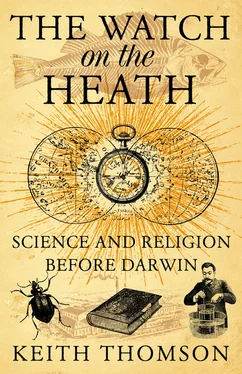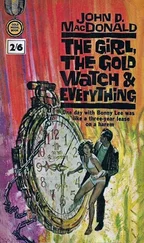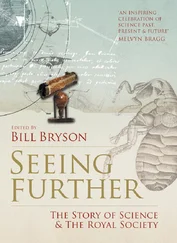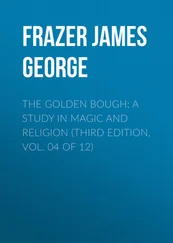In crossing a heath, suppose I pitched my foot against a stone, and were asked how the stone came to be there, I might possibly answer that, for any thing I knew to the contrary, it had lain there for ever; nor would it perhaps be very easy to shew the absurdity of this answer. But suppose I had found a watch upon the ground, and it should be enquired how the watch happened to be in that place … why should not this answer serve for the watch, as well as for the stone? … For this reason, and no other, viz. that, when we come to inspect the watch, we perceive, (what we could not discover in the stone,) that its several parts are framed and put together for a purpose, e.g. that they are so formed and adjusted as to produce motion, and that motion so regulated as to point out the hour of the day; that, if the several parts had been differently shaped from what they are, of a different size from what they are, or placed after any other manner, or in any other order … none which would have answered the use, that is now served by it … This mechanism being observed, (it requires indeed an examination of the instrument, and perhaps some previous knowledge of the subject, to perceive and understand it) … the inference, we think, is inevitable; that the watch must have had a maker; that there must have existed, at some time and at some place or other, an artificer or artificers who formed it for the purposes, which we find it actually to answer; who comprehended its construction, and designed its use.
In this analogy the watch stands for all living organisms; the ‘who’, of course, is God. A modern wristwatch is a dull, efficient affair. Paley’s watch would have been a large hunter or repeater enclosed within a silver or gold case. The back would hinge open to reveal a world in miniature of revolving gears in shining brass, tiny oscillating devices, and a great central spring, perhaps even (if a repeater) tiny bells to signal the quarter hours. The mechanics alone would qualify as a work of art as well as artifice. Paley’s conclusion leaps from the page: the springs, gear wheels and all the other bits and pieces of the watch represent the heart, the muscles, nerves, joints and all the thousands of tissues that constitute a living creature. If the watch and all its precisely interacting parts are made for a purpose, we are forced to conclude that we humans and all of living nature are also made to accord with a particular vision.
On the face of it, Paley’s premise is incontrovertible. A watch could not have appeared out of thin air. It did not chip off something else, as the stone might have done. It did not grow out of the ground like the grass on the heathland. Any machine must be made; in the case of something so intricate as a watch, it requires a detailed plan and a craftsman of great skill. And, given that it has been made so carefully, even someone who had never seen a watch before would conclude that it must have some purpose, a function. Every machine of human invention, all its parts neatly functioning, precisely adapted to each other and to the whole, must exist for a purpose. (If you set out to make a machine that had no purpose, then that would then constitute its purpose.) From this it follows that the more we study natural organisms – the elegant ‘machines’ of nature – the more we will learn about and confirm the power, purpose and goodness of the Creator. Construed thus, science is an exercise in piety and the sciences dealing with life on earth provide an unending catalogue of arguments about the existence and benevolence of the Creator.
The concept of the body as a machine would have been as familiar to Paley’s readers as the clockwork universe. A machine analogy for natural phenomena had long been a consistent element in Enlightenment philosophy. Leonardo da Vinci and the anatomists of the sixteenth century had seen the mechanical elements of a machine in the levers and pulleys of the skeleton and William Harvey, with the discovery of the circulation of the blood, made the body a dynamic mechanism. When Robert Boyle asked him what had inspired his discovery,
[Harvey] answer’d me, that when he took notice that the Valves in the Veins of so many sevral parts of the Body, were so plac’d that they gave free passage to the Blood towards the heart but oppos’d the passage of Veinal Blood to the Contrary: He was invited to imagine, that so Provident a Cause as nature had not so Plac’d so many valves without Design: and no Design seem’d more possible than that … it should be Sent through the Arteries, and Return through the Veins 10 .
Having given the outline of his case, on the very second page of his book Paley moved summarily to dispose of some easily anticipated criticisms.
Nor would it, I apprehend, weaken the conclusion, that we had never seen a watch made … Neither, secondly, would it invalidate our conclusions, that the watch sometimes went wrong, or that it seldom went exactly right … It is not necessary that a machine be made perfect, in order to shew with what design it was made … Nor, thirdly, would it bring any uncertainty into the argument, if there were a few parts of the watch, concerning which we could not discover, or had not yet discovered, whether they conduced to the general effect.
These are the sorts of objections that any reader might raise, especially as, in 1802, the mysteries of reproduction were still just that, everyone fell ill at times (Paley was seriously ill as he wrote the book), scholars had long wondered about the uses of the apparently functionless appendix, and so on.
Paley was concerned with far deeper issues than this, however. He launched into a debate with all the leading ‘atheistic’ positions of the day. In Paley’s typically eighteenth-century prose and sharp argumentation, the reader discovers a set of special issues and opponents. He fires off shots at a whole range of philosophers and philosophies, from Descartes to Locke, from Buffon to Erasmus Darwin. Their challenges to the foundations of Christian belief are both the immediate and eternal reason for his book. His special preoccupation is with what he considered the ultimate heresies – evolutionary theories. If Paley’s arguments were framed in terms unfamiliar to modern readers it is because we have variously absorbed and discarded Locke on understanding and Cartesian/Epicurean atomism, and Buffon’s and Erasmus Darwin’s ideas about evolution were long ago rendered extinct by those of Charles Darwin.
William Paley devoted his life, and particularly his great skills as a thinker and writer, to God and will long be remembered as the man who set out nothing less than a proof of the ‘existence and attributes of the Deity’. Natural Theology was Paley’s last book, written in his old age. While even the most assertive or arrogant of intellectuals might have hesitated at attempting to produce a definitive proof of the existence of God – and Paley’s book certainly shows itself as the work of someone who is very confident – in life he was modest and quiet, a somewhat shy, shambling figure, built short and square, and by 1800 suffering terrible pain from what was probably abdominal cancer. The only known portrait shows a man with a smile to light up even the most dreary northern winter day. His deep, quiet voice – always too soft for a properly dramatic manner at the pulpit – was the voice of calm and reason. As a student, he had never dreamt of adopting the citified modes of speech of Cambridge and London. His rough-hewn manner allowed him to speak directly to his flock and no one criticised or mocked his outmoded coat, his old-fashioned hat or his wrinkled stockings. At his prime, his sermons persuaded, cajoled and inspired rather than insisted or threatened. Those sermons, like his life, were full of wit and wisdom and coloured with just enough liberal thinking to make his superiors uneasy. As for inspiration, he never hesitated to build upon the works of others, indeed he mischievously advised young clerics: ‘if your situation requires a sermon every Sunday, make one and steal five’. Towards the end of his life he walked with a broken, rolling, seaman’s gait and would stop occasionally to recite aloud snatches of poetry or to sing.
Читать дальше












